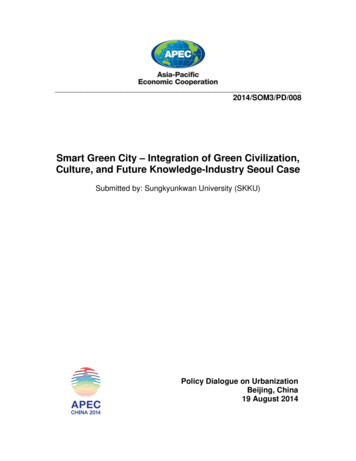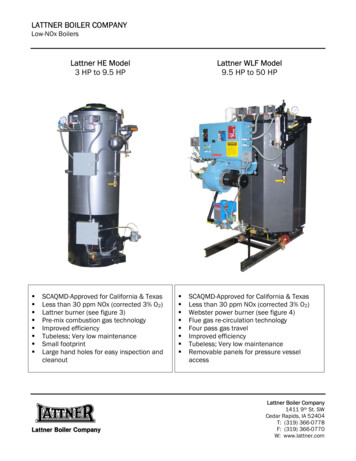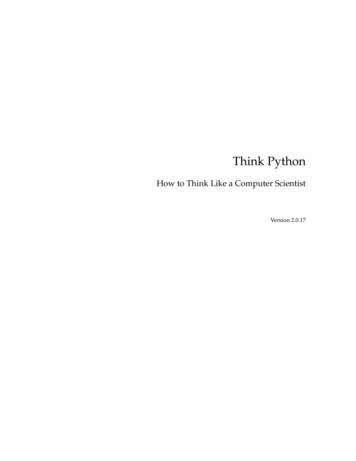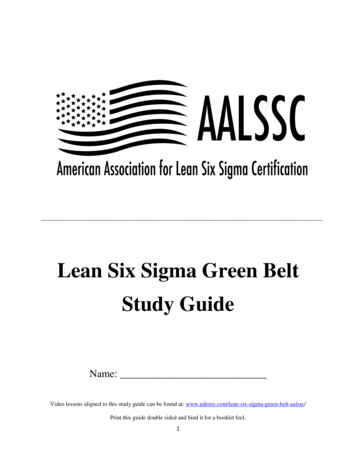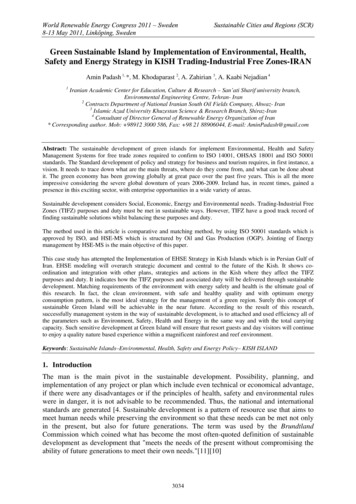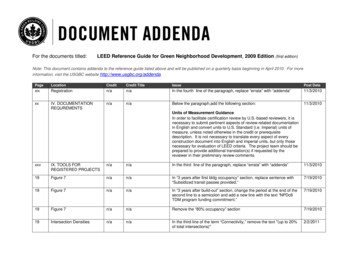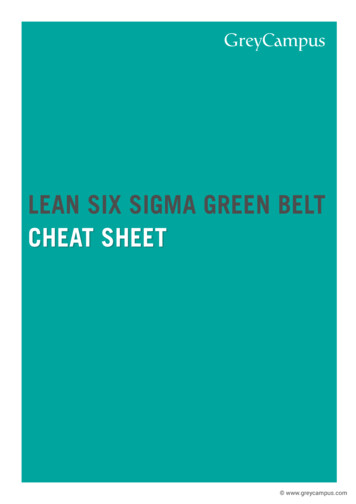
Transcription
A Green logistic model for both cost andemission minimization under inventorypoliciesBachelor Thesis Econometrics and Operational Research - LogisticsAnouk Goos345451June 2014Supervisor: Rommert Dekker1
AbstractThis report aims to find an optimal supply chain network with 22 European distribution centers fortwo types of refrigerators produced in China. The supply chain will be optimized in such a way thattransport costs and emission costs are minimized and inventories are perfectly located. First a modelis created where only a truck is used, secondly the train will be introduced and after that the bargewill be included. This is followed by the implementation of inventories and safety stock. It is analyzedat which place, distribution center or demand region, the safety stock should be located. In the finalmodel the costs of emissions are incorporated to create a green supply chain.Keywords: optimization, supply chain, costs CO2 emission, transport costs, environment, AIMMS2
Table of contentsContentsAbstract . 2Table of contents . 31Introduction . 52Literature review . 63452.1Previous research . 62.2Conclusion from previous research . 62.3Limitation of previous research. 72.4Further research . 7Model description . 83.1Network design . 83.2Objective. 83.3Solver . 8Input Variables . 94.1Demand prediction . 94.2Distances . 94.3Cost of transportation . 94.5Emissions . 104.6Cost opening DC . 104.7Lead time . 104.8Holding costs . 114.9Safety stock . 114.10Cargo weight. 11Mathematical Models . 125.1Model 1 . 125.1.1Results . 135.1.2Sensitivity analysis . 145.1.3Conclusion . 155.2Model 2 . 155.2.1Results: . 165.2.2Sensitivity analysis . 163
5.2.35.3Conclusion . 17Model 3 . 175.3.1Result . 185.3.2Sensitivity analysis . 195.4Model 4 . 195.4.1Results . 205.4.2Conclusion . 215.5Model 5 . 215.5.1Results . 225.5.2Conclusion . 246Conclusions. 257Limitations . 268References . 279Appendices . 29Appendix A: Clear overview of the three sets . 29Appendix B: Clear overview of the parameters . 29Appendix C: Results model 1 . 29Appendix D: Model 2 . 30Appendix E: Results model 2 . 31Appendix F: Model 3 . 32Appendix G: Results model 5.4 . 32Appendix H: Results Model 5.5.1.1 . 33Appendix I: Calculation Transportation Costs from Bucharest to all DR for Model 5.5.1.1 . 34Appendix J: Calculation Emission costs Model 5.5.1.2 . 344
1 IntroductionEnvironmental issues have become increasingly important over the years. In Europe the EuropeanUnion sets out the emission standards for all transportations modes. The European Commission( the executive body of the European Union) published several reports and action plans such as‘‘Freight Transport Logistics Action Plan’’(European Commission, 2007), ‘‘Greening Transport’’(European Commission, 2008a), ‘‘Strategy for the Internalization of External Costs’’ (EuropeanCommission, 2008b), ‘‘A Sustainable Future for Transport: towards an Integrated, Technology led andUser friendly System’’ (European Commission, 2009). However, one of the most influential policies isthe Kyoto protocol, which is mainly focussed on road and freight transport (Chapman, 2007). Allthese reports, actions plans and policies support the use of environmental friendly transportationmodes and other economic instruments as taxes. In this research the focus is on the affect ofenvironmental issues on the design of the supply chain.Since the global trade grew from 57.5 billion USD to 3600 billion USD (Tavasszy et al., 2011) between1948 and 1992, the supply chain has developed to an extensive and complex network that connectsproduction locations with demand regions (DR) all over the world. However, the increase of theglobal trade resulted in an increase of global transport volumes. The transport, mainly freighttransports, leads to a release of large amounts of emissions.Though environmental issues and related cost of emissions are considered, cost minimization ofsupply chain operations is undeniably the most important objective for supply chain network designtoday (Mallidis et al., 2012). Therefore this study aims to provide a cost and CO2 optimization forrefrigerator supply chain to the whole EU, without assumptions limiting the number of possibilities.This implies the lack of a restriction on the amount of ports, distributions centres (DCs) and DRs. Twomodels of Haier refrigerators are transported namely HT21TS77SP (big model) and HNSE032 (smallmodel).Since inventories are related to the number of DCs in the supply chain; more DCs means a largeramount of inventory in total which contributes to higher costs, but on the other hand more DCsgenerates a quicker response to the retail stores which provides a higher service level. Hence,additionally to the cost minimization and the design of a green supply chain, this study includes abetter1 modelling of inventories in the model and assess its effect on the optimisation.Finally this study provides an extensive sensitivity analysis of the input parameters and the effect ofvarious data and model assumptions.This research will combine the minimization of costs, CO2 emission and incorporate an efficientinventory planning. To do so, this study is structured as follows: in section 1 previous research isevaluated and the main findings of this research are discussed. Followed by an explanation whyfurther research is required. In section 3 a description of the obtained data is given. Section 4describes the different objective models. Section 4 consists of 5 models, for each model the resultsare given, a sensitivity analysis is provided and finally followed by a conclusion. In section 5 a generalconclusion of all models is given.1better than obtained from research in the seminar Seminar ‘’Supply Chain Management and Optimization’’5
2Literature review2.1Previous researchRelated research can be classified in three categories:1. Research related to supply chain network designThe design of a supply chain network incorporates decisions among the number, locations,and capacities of the DCs. Besides, the company must make a selection of differentintermediate parties, as suppliers and freight forwarders, in such a way that the goalsregarding to cost and product delivery time are met (Klibi et al., 2010). After that, animportant choice is made about the use of transportation modes and the cargo volumestransported (Melo, Nickel, Saldanha-da-Gama, 2009).2. Research related to a green supply chain networkEnvironmental issues is become increasingly important in recent years, this implies that onlyrecent research is provided about supply chain management considering the environment.Most recent study is given in Dekker et al. (in press). A first classification of this researchefforts include green product design and manufacturing studied by Luh et al. (2010), Chu etal. (2009), and O’ Brien, 1999, green transportation and distribution studied by Neto et al.(2008), Li et al. (2008), Ramudhin et al. (2009), Iakovou et al. (2010), green warehousingstudied by Emmet and Sood (2010) and Mckinnon et al. (2010)3. Research related to supply chain network and related inventory planningChung and Wee, 2010, Chen and Monahan, 2010 and Ahiska and King 2010, Wee et al 2011and Hsueh, 2011) providing research related to a tactical policies related to inventorymanagement.However, several researchers have already tried to evaluate the environmental impact of freighttransportation, mainly on CO2 emission. They proposed different strategies to mitigate CO2 emission(Liao et al., 2011; Chapman, 2007; Hickman et al., 2011).In this research is mainly focussed on two articles both provided by Mallidis, Dekker and Vlachos.Both Mallidis et al. (2012) and Mallidis et al. (2014) incorporated the literature stated above. In thefirst art
refrigerator supply chain to the whole EU, without assumptions limiting the number of possibilities. This implies the lack of a restriction on the amount of ports, distributions centres (DCs) and DRs. Two models of Haier refrigerators are transported namely HT21TS77SP (big model) and HNSE032 (small model). Since inventories are related to the number of DCs in the supply chain; more DCs means a .
